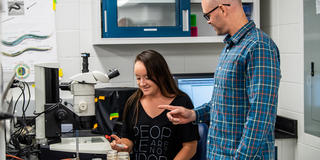
Overview
The educational programs offered through our Department of Chemistry and Biochemistry combine an understanding of fundamental scientific principles with an intensive laboratory research experience. You’ll have many opportunities to engage in research that advances the boundaries of scientific knowledge. Whether an undergraduate or a graduate student in any of our programs, you’ll have the chance to work in close collaboration with a faculty research advisor on research projects. The results of these projects are advancing scientific knowledge and applications. Our faculty publish their work regularly with undergraduate and graduate student authors.